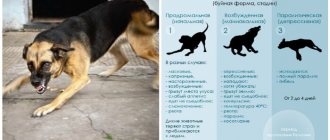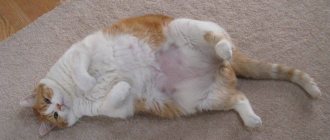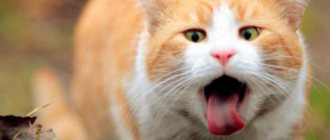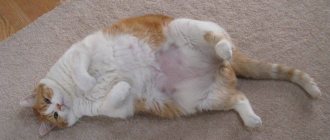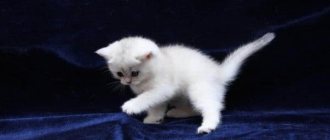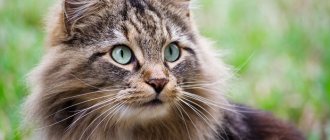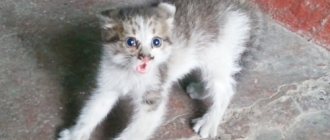Common reasons
What was the exact provoking factor for the cat to start foaming at the mouth can only be determined by a specialist. This is because there are a very large number of reasons, and they are not always harmless, just as they are not always catastrophically dangerous. Foaming at the mouth of a small kitten can occur under the same circumstances as in an adult pet.
Physiological factors:
Foamy saliva during pregnancy. Cats also experience a condition similar to female toxicosis during pregnancy. Most often, this phenomenon is observed in the morning, after each awakening from sleep or almost immediately after eating. There may be a color change to slightly yellowish or the color of the food you eat. The general condition of the cat does not change; appetite and activity are preserved.- Sometimes a very strong nervous shock or stress can provoke the release of foam in the corners of the mouth. Usually it is so minor that the condition can be considered simply as increased salivation. It may go unnoticed.
- Foam mixed with wool is typical for long-haired breeds. This is a sign that the pet has licked or swallowed its own hairs, which, irritating the mouth and stomach, cause increased salivation and/or vomiting. There is always fur in the vomit, the foamy contents are white, and cases are most often one-time. This also does not affect the general condition of the cat; the level of vital activity remains at the same level after the stomach has emptied of fur.
- White foam that appears once may be evidence that the mustachioed pet has been starving for a long time and has an empty stomach. Excess gastric juice accumulates in the stomach, which begins to irritate the surface of its mucosa. This provokes excessive production of protective mucus, which, mixed with gastric juice and air, forms foam and is expelled through vomiting.
- The discharge of foamy liquid from the mouth always accompanies a reaction to any bitterness - for example, bitter medicines (syrups or tablets). Bitters should be taken with plenty of water. At the same time, the general condition of the animal does not deteriorate; it usually drinks, eats and behaves.
Pathologies of the oral cavity and gastrointestinal tract:
- The release of foam can be explained by pathologies of the oral cavity (for example, stomatitis or a foreign body in the soft tissues of the mouth). These moments are always accompanied by intense production of saliva, which, interacting with air, is converted into foam. To confirm this reason, it is enough to simply examine the animal’s oral cavity.
- Green or whitish foam, which is mixed with green vomit, indicates a violation of the digestive process, when food from the intestinal tract is thrown back into the stomach along with bile and provokes vomiting. This is already a reason to contact a veterinarian to find out the cause of such a violation, because... Along with simply eating green grass, this may be a sign of a severe digestive system infection or intestinal blockage.
- If pink or red foam appears, this is the first sign of bleeding. Based on the shade and intensity of the color of the foamy saliva, one can guess where the source of the bleeding is and what the cause of this condition is. A faint pink color may indicate minor injuries or mouth ulcers. It is enough to examine the mouth to detect the source of bleeding. Bright red foam may indicate bleeding in the esophagus due to the presence of foreign bodies and/or internal trauma (for example, from bones). If there is a brown tint, then this is a signal of problems with the stomach (peptic ulcer or gastritis) or with the liver (hepatitis). If there is red or brown foam, you do not need to try to help yourself; you need to contact a veterinarian.
Let's understand the reasons
There are many reasons why an adult cat or kitten foams. However, if this phenomenon is detected, it is important to make sure that the pet is healthy. You need to pay attention to other symptoms, monitor the animal and, if necessary, contact a veterinary clinic. Do not rush to do something without understanding the situation, and without the recommendation of a specialist.
So, foam can go if:
- this is the result of stress or severe fear;
- this is how severe pain often manifests itself;
- poisoning;
- when exposed to bitter substances, for example, often from bitter medicines;
- The cat cleanses the stomach of fur in this way;
- the animal has choked or there is a foreign object in the mouth;
- dental problems;
- gastrointestinal diseases (enteritis, hepatitis, etc.);
- viral diseases (calcivirosis);
- brain damage, for example, a blow, bruise;
- heart attack;
- sign of rabies.
Vomit color
In order to establish the cause, you need to pay attention to the color of the vomit. If your cat has white foam mixed with fur, then you don’t have to worry - this is a natural process of self-cleaning of the stomach. To prevent this from happening again, it is important to regularly brush your pet and remove hair, especially during shedding.
White foam can indicate an empty stomach, for example, this happens in the morning before breakfast if a cat or baby is hungry. But if vomiting white foam is repeated frequently, this may indicate a serious stomach illness; the animal should be shown to a doctor.
If the foam is green, then the cat may have simply eaten grass or produced too much bile. If it occurs frequently, it is a sign of infection. Frequent gagging and foaming cannot be considered harmless. It is important to remember that against the background of general weakness and apathy, this may be a symptom of plague or panleukopenia. It is important to do an analysis right away.
The discharge of white foam with blood cannot be ignored. If small clots of bright blood are visible, this may indicate an injury in the mouth or esophagus; the cat may have been injured or swallowed an object. If the foam is brown from blood, then the bleeding is internal, and your pet needs to be shown to a doctor immediately. This may be an injury to the walls of the stomach or an exacerbation of gastritis.
Vomiting foam with a yellow tint may indicate that bile has entered the stomach. The walls of the stomach react to this manifestation by vomiting. If the symptom is repeated more than once, then this is due to a chronic disease of the gallbladder, liver or intestines. This is often due to overfeeding the pet with fatty heavy foods and eggs. Sometimes this phenomenon is provoked by chemical additives from industrial feed. It is necessary to check these bodies.
Sorry, there are no surveys available at this time.
When foaming at the mouth is a sign of serious illness
The basic rule in which foaming from the mouth may indicate serious problems in the pet’s health is any accompanying symptoms that change the general condition of the animal (loss of consciousness, convulsions, unsteady gait, etc.) and a high frequency of foaming. In such conditions, providing independent assistance is not advisable; it is necessary to show the mustachioed pet to a veterinary specialist as soon as possible.
- Any severe poisoning with toxic substances (for example, rat poisons or household chemicals) or overdose of certain medications is often accompanied by the release of foamy saliva. In the future, this phenomenon may be accompanied by vomiting, diarrhea, unsteady gait, dilated pupils, sometimes convulsions or loss of consciousness.
- Epileptic seizures in cats are also accompanied by the release of foam from the mouth, as well as convulsions, involuntary emptying of the bladder and intestines, and tension in the limbs. Foamy discharge may change color to pinkish - a sign that there is blood in the oral cavity (for example, biting the tongue, the inside of the cheeks or lips).
- Late stage rabies is manifested by foaming and profuse salivation. In addition to these signs, the sick animal has hydrophobia, paralysis of the lower jaw and the inability to swallow (Murka appears to have choked). In case of rabies, the presence of foam from the mouth is already a guarantee that the animal will die. Always with foam at the mouth and convulsions, rabies is first ruled out, because The disease is also dangerous for humans.
- The cat is foaming at the mouth with increased salivation due to panleukopenia (feline distemper in common parlance) - a serious viral infection, which is additionally accompanied by an increase in body temperature, discharge from the eyes and nose. The color of the foamy discharge is white, without impurities in color or composition. The immune system suffers greatly, intensive therapy is required, otherwise death cannot be avoided.
- Inflammation of the meninges and concussion are also accompanied by the release of foam from the mouth and nervous disorders (convulsions, tics, unsteadiness of gait).
- Severe pain of any localization can be accompanied by the formation of foam from the cat’s mouth. Especially pain in the head area (otitis media, toothache). In this case, the animal takes a forced position, tries to move less, and tremors may appear in the body.
- Helminthic infestations - with severe infection, vomiting may occur directly in foam, in which parasites are directly detected. In this condition, self-prescription of anthelmintic drugs is prohibited!
When to start sounding the alarm
Vomiting blood in a cat: reasons, what to do
In addition to physiological reasons, there are situations when it is worth acting immediately so as not to aggravate the situation and give the animal a chance for a further healthy life. There are a number of pathological health problems that can cause cats to foam at the mouth.
Epilepsy
This disease is caused by a serious pathology of the brain. To identify epilepsy, you should know what its main symptoms are:
Epilepsy in a cat
Epileptic seizures in cats can occur with different frequency: in some - once a week, and in others - 1-2 times a year.
Attention! Sometimes the foamy growths may turn pink, a sign that the tongue or the outer part of the cheeks was bitten during the seizure.
Poisoning
The appearance of foamy formations can be caused by poisoning of the cat, for example, household chemicals, flower poisons, poor-quality food, or something else. Symptoms of poisoning are as follows:
- diarrhea;
- nausea and vomiting;
- complete apathy or, on the contrary, irritation;
- dilation of the pupils is observed;
- body temperature below 38 degrees;
- tachycardia;
- unsteady gait.
Plague
The scientific name of the disease is “panleukopenia”, and in common parlance it is feline distemper.
To recognize this disease, you should pay attention to the following symptoms:
- high body temperature, reaching 41-42 degrees;
- vomiting with foam, mucus or blood;
- urine becomes darker;
- one or both eyes water and purulent discharge occurs;
- the cat completely refuses water;
- frequent and intermittent breathing;
- The cat looks for a distant corner in the house, where it then lies for a long time.
For reference: contrary to popular belief, feline distemper is not dangerous to humans. Therefore, the animal owner can and should help the pet.
Infections
Infectious diseases can provoke foamy discharge from the mouth, and the worst among them is rabies.
The disease can be mild or severe. During a mild form, the animal becomes apathetic, afraid of light and refuses any food. In the acute form, there is excessive affection towards the owner, which gradually develops into aggression and attack. Also, the cat may eat inedible objects, the eyes become cloudy, the pupils are dilated, and saliva is released profusely.
Important! Rabies is dangerous to humans. If you have any suspicions, after being bitten by a cat with symptoms of the disease, you should immediately go to the hospital for qualified help. Once the virus has penetrated the nerve fibers, the process becomes irreversible.
Today there is no cure for rabies and therefore this disease ends in the death of the animal.
Gastrointestinal diseases
Foam formations can occur in the presence of gastritis, pancreatitis, enteritis, ulcers and other problems. Each of the diseases has its own symptoms, but common ones include constipation, diarrhea, flatulence, pain, complete lack of appetite, vomiting with blood, as well as deterioration in the appearance of the animal.
Gastrointestinal problems in animals
What to do
- If the owner knows that the cause of the phenomenon is fur, he should clear the mouth of hairs and/or wait until the vomiting ends, during which the fur will come out on its own. Afterwards, it is advisable to purchase and give a special paste to remove hair from the cat’s body naturally. Before purchasing the paste, it is enough to give your pet a teaspoon of Vaseline oil.
- If, upon examination of the oral cavity, signs of stomatitis are found, you need to contact a veterinary hospital to prescribe adequate therapy (usually antibiotics, antiseptic and wound-healing pastes and ointments are prescribed).
- If there is a suspicion of an epileptic seizure, the animal is carefully laid on its side on a flat, hard surface, and all possibilities of injury from hitting surrounding objects at the time of convulsions are excluded. You need to wait until the attack ends and take the cat to the veterinary clinic.
- If there is a suspicion that your pet has become infected with an infectious disease, then it is not advisable to take any independent measures; you need the help of a specialist. Depending on the type of infection, antibiotics, antiviral agents, restorative and immunostimulating drugs, rehydrating droppers, etc. are prescribed.
- If there is a suspicion that the cat/cat/kitten has been poisoned, it is necessary to induce vomiting or wait until it ends, give any sorbent that is in the first aid kit (activated carbon or polysorb) and take the animal to the veterinarian. If signs of poisoning are accompanied by damage to the nervous system (convulsions or loss of consciousness), then self-help is prohibited, only sending to a hospital!
- If the foam at the mouth is explained by the presence of a foreign object in the mouth or larynx, you need to start by monitoring the condition of the animal - sometimes in the process of natural vomiting the foreign body is removed without problems. If the traumatic element is in the mouth and can be easily removed on your own, there is no need to hesitate, you need to remove it. If the foreign body is invisible (but it is known for sure that it is there) or it is impossible to get it out on your own, there is no need to hesitate to visit a veterinarian.
- If worms are found in the foamy vomit, you should consult a veterinarian at the first opportunity about the name of the anthelmintic drug and carry out deworming. You can carefully collect the parasites with gloved hands in any small glass container and also show them to the veterinarian to determine their type and select a more accurate drug.
Important: examination and any manipulations with a pet who is foaming at the mouth should be carried out only with rubber gloves to prevent the animal from contracting possible infectious diseases (for example, such as rabies).
First aid
If your cat is foaming at the mouth, it is important to understand what caused it and what measures to take to alleviate the animal's condition. First of all, the owner determines what caused the foam from the mouth
If a trichobezoar is stuck in the stomach, the cat is given Vaseline oil or flaxseed oil, which promotes the rapid removal of the hairball with the act of defecation. Regular administration of malt paste can prevent the formation of trichobezoars.
If the reason your cat is foaming at the mouth is damage to the gums or teeth, then first aid is to disinfect the mouth with an antiseptic solution and contact a veterinary clinic. The doctor prescribes special ointments, which the owner can put into the animal’s mouth himself.
Intoxication of the cat’s body, provoked by drugs, chemicals, zoocoumarins, requires the intervention of a veterinarian. At home, you can give enterosorbents or do gastric lavage. If the cause of cat poisoning is poor quality food, first aid is a starvation diet.
Naturally, if your pet’s condition causes any danger, then it is better to contact a veterinarian, but it is also necessary to promptly provide the correct assistance to the cat:
- If the owner is sure that the cause of the malaise is the hair that has gotten inside, then for a better release of the hairball, the cat can be given one teaspoon of Vaseline oil.
- For diseases in the oral cavity, the veterinarian prescribes antiseptic drugs, ointments and antibiotics.
- If a kitten shows signs of poisoning on its face, then you need to urgently contact a veterinarian and give it absorbents, for example, activated carbon, polysorb, polyphepan.
- When a kitten experiences convulsions, it needs to be placed on a flat surface. The head must be firmly fixed to one side, this is necessary so that the animal does not suffocate from vomit. Use a spoon to remove your pet's tongue.
READ How to treat cat ears at home
Foaming from the mouth of a cat plus accompanying symptoms indicate severe pathologies in the animal that require immediate attention from a veterinarian. You cannot treat your pet at home on your own; there is a high chance of making a mistake about the cause and aggravating the course of the underlying disease, even leading to death.
When you need to deliver a cat to the RosVet Exhibition Center:
- poisoning (chemicals, rat poison, medications, etc.) is accompanied by copious amounts of foam from the cat’s mouth, coupled with vomiting, diarrhea, dilated pupils, convulsions up to coma;
- epilepsy in cats. Seizures are accompanied by blistering discharge, convulsions, involuntary emptying of the bladder and bowels;
- rabies. Along with foam, fear of water, paralysis of the pharynx and lower jaw, and convulsions appear;
- panleukopenia (plague). Viral infection, occurs with hyperthermia, discharge from the eyes and nose;
- inflammation of the brain (concussion). Foam as a symptom is accompanied by signs: unsteadiness of gait, convulsions.
The formation of foam in a cat provokes severe pain in any location, but especially in the head area. With a severe infestation of worms, vomiting with foam and parasites is a typical sign. In this case, it is prohibited to give anthelmintics yourself; you need to urgently take the cat to the clinic.
How to warn?
If you follow a number of preventive measures, it is quite possible to avoid such an unpleasant phenomenon as foaming at the mouth:
- Regularly and thoroughly comb long-haired pets and periodically give a special paste to remove hair from the stomach naturally.
- Avoid feeding food that can injure the mucous membrane of the esophagus or oral cavity, causing inflammation and excessive production of saliva.
- Keep household chemical liquids and household poisons out of reach to avoid accidental ingestion by your cat.
- The use of any medications is allowed only with the prescription of a veterinarian and in dosages also specified by the veterinarian. Give bitter medicines with plenty of liquid.
- Regularly and promptly vaccinate against infectious diseases that occur with such symptoms.
Question answer
White foamy discharge from the cat's mouth and no other symptoms
Usually, a single appearance of white foam from a cat’s mouth indicates prolonged hunger or intense helminthic infestation. It is enough to give the animal something to drink and feed. If there is a suspicion of infection with worms, then you should take your pet to the veterinarian to select the correct anthelmintic agent and its dosage. The animal may also be in pain.
The cat is foaming at the mouth after taking medicine (after a pill)
This reaction occurs in two cases - either the dosage was calculated incorrectly and more medicine was given than necessary, or the drug itself tastes bitter. In case of an overdose of medications, you should go to the veterinary clinic. In the second case, it is enough to give water to drink (pour it into the mouth from a disposable syringe without a needle).
If your cat is having convulsions and is foaming at the mouth
Options: severe poisoning, epilepsy or other infectious disease accompanied by damage to the nervous system. Reason for an urgent visit to the veterinarian.
Foaming at the mouth along with vomiting
If you experience vomiting with foamy discharge, the options may be the following: hungry stomach cramps, blockage of the stomach or intestines, worms (can be found in the vomit directly in the foam). Vomiting with pink foam is evidence of the presence of bleeding, yellow or green - indigestion when bile or intestinal contents enter the stomach.
Pregnant cat foams at the mouth
Isolated cases of discharge from the mouth in pregnant women in the absence of any other accompanying signs are acceptable and are equated to a state of toxicosis. The general condition of the animal should not be disturbed.
Reasons if increased saliva secretion turns into foam
Pathologies of the oral cavity and upper gastrointestinal tract are almost always accompanied by profuse salivation. A large amount of saliva turns into foam upon contact with air.
Cat foams at the mouth after flea treatment
Most likely, the rules for applying blood-sucking insect repellent were violated. There are special points for applying the product in the withers area and along the spine, where Murka cannot lick it off. If applied incorrectly, apparently, the animal licked it off, which caused a similar reaction. The product can be safe, but bitter (just give it some extra water), it can be toxic and cause poisoning - you need the help of a specialist.
If you foam at the mouth after abdominal surgery (sterilization, for example)
Any abdominal surgical interventions must be performed under general anesthesia. Different cats also recover from anesthesia in completely different ways. Sometimes this process is accompanied by vomiting and/or increased production of foamy saliva. If nothing else bothers the animal, it is enough to give it liquid to drink and wait for the condition to normalize. If the process of recovery from anesthesia takes up to 1.5 days, then this is a reason to seek advice from a specialist.
Author:
Grinchuk Ekaterina Andreevna veterinarian
